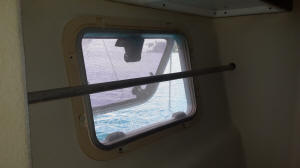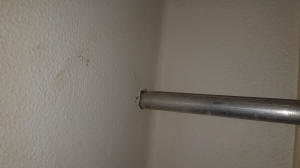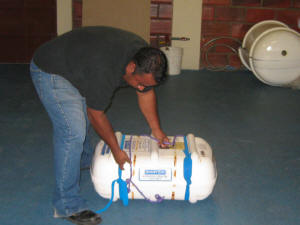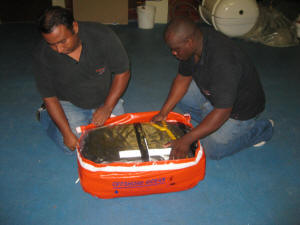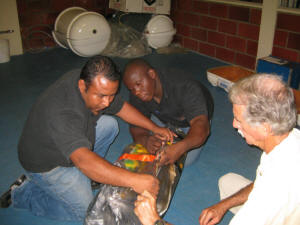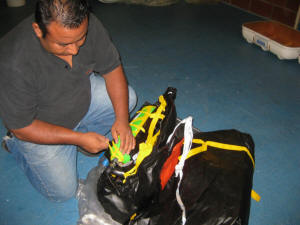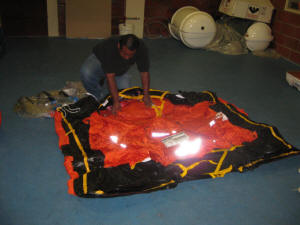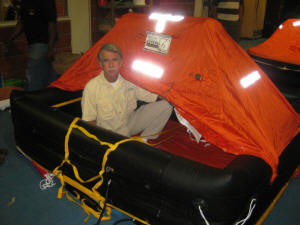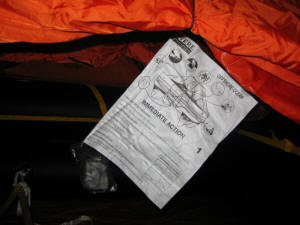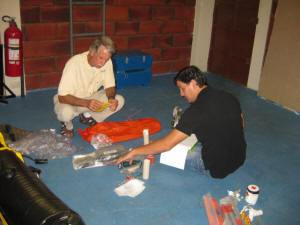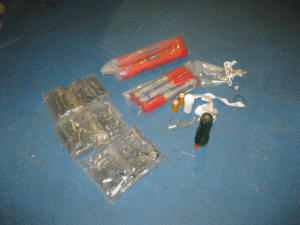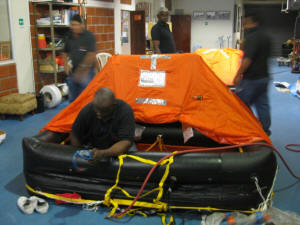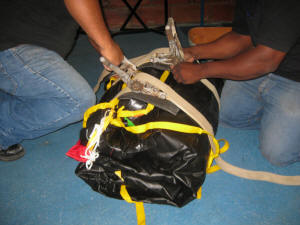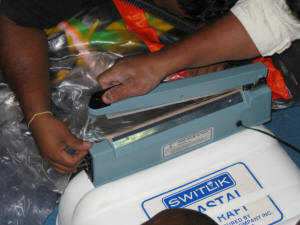|
St Francis |
|

| Recommended Reading | Tools and Spares | |
| Liferafts | Making Your Boat Secure |
Last Updated: 03/26/2023
Here are the guides that have helped me learn how to do repairs on my own, and which I still refer to over and over.
Nigel Calder's Boat Owner's Mechanical and Electrical Manual
Nigel Calder's Marine Diesel Engines
Nigel Calder's book on
Refrigeration
Brian Toss's The Complete Rigger's Apprentice
And see my comments on acquiring all the shop manuals for the equipment on your boat.
The subject of what tools and spares to carry is one of those
never ending boating compromises. Weight and space vs more stuff.
Personally, I don't think you can ever have too many tools aboard as long as
you have the space. In a catamaran, we have plenty of space, but we must be
mindful of the significant drawbacks and risks of overloading a boat that is
designed to be light.
What you carry depends a lot on what equipment you have aboard, how involved
you plan to be with the mechanical and electrical repairs on your boat, and
how far afield you plan to go. If you plan on using hired mechanics or
staying close to the US, you may not need many tools at all beyond the
basics. On the other hand out here in the boonies proper tools are hard to
come by and expensive even for the hired mechanics. As an example you may
not like the 3 lb sledge the mechanic is planning on using on your delicate
pump to get it apart because they don't have the right tool. There have been
many articles written in the sailing magazines regarding tool kits for
boats. Do a little internet research and I'm sure you can come up with them
to start you off with the basics.
I also don't think that you can have too many spares. I obviously haven't
used all mine yet, but it sure has been nice to have them when I needed
them. For instance, I recently replaced a leaking injector line with an
onboard spare off the Panama coast in a rainstorm. Without it and the
engine, it would have been a nightmare getting in to our San Blas anchorage.
As another example, 50 amp diodes for the larger alternators over 100 amps
are hard to find down here. The common smaller automotive alternators use 30
amp diodes and that is what most alternator repair shops will have and want
to use. I learned that lesson several years ago here in Cartagena and now
have learned to do my own overhauls with the right diodes and other parts.
Also shipping/customs/handling from the US or elsewhere is often equal to or
more than the cost of the parts. I also carry a full assortment of stainless
fasteners, plumbing fittings, electrical connectors/wire, etc, etc because
the hardware stores out here are never conveniently located just around the
corner. If you think that you may need it and it is not something basic you
better bring it with you.
I have recently acquired a set of new lithium battery-powered hand tools,
and love them.
Here are some other specialty tools I find
useful for long term cruising. This is by no means a complete list of what
you may need but rather often used tools off the top of my head:
Electrical repair:
-Battery load tester
-Lug crimper for large electrical
cables
-Craftsman AC/DC clamp multimeter
-Battery electrolyte/engine coolant tester
Electronics repair:
-HF and VHF SWR/power out meter
-HF Dummy load
-adjustable heat pencil tip soldering iron
-solder sucker
-head magnifying
glass
-soldering vice tool
Rig and Sail repair:
-Butane powered line cutting
tool
-Robust sewing machine and associated tools
-Sail repair kit and tools
-Loos tension guage for tuning the rig
-100' tape measure
Electric tools:
-4.5" grinder with cutting, grinding and sanding wheels
-Sawsall
-Quality
Bosch style saber saw
-Laser temperature gun
-Electronic tachometer gun
-1/2" drill
-Dremel tool kit
-Precision Battery Tester
Refrigeration repair:
-gauges
-vacuum pump
-flare tools
-electronic leak tester
Engine repair tools for your engine:
-large sockets/wrenches for pulley and flywheel nuts
-complete set of
gaskets/seals
-valve setting/engine alignment tools
-prop pulling tools
Other tools
-Set
of Titanium drill bits
-Drill bit set to 1"
-Hole saws to 4"
-Minature
screwdriver set
-Tap and die sets for SAE and
-metric Plumber's socket set for stanchion nuts
- Shop Manuals and Schematics
If you are really serious about having the right tools aboard then take the
time to take apart and put back together ALL your critical equipment. Buy
the tools you need to do that and you will be on the right track. Then
there's what to buy for the "nice to have stuff". Consult with your wife on
that, because you are going to be competing with her for storage space by
then.
You can spend a fortune on tools for a boat. In the past I have bought many
tools from places like Harbor Freight. I have had very few failures and
still have some that I bought over 10 years ago. I think that many of the
expensive brand names like Bosch, Craftsman, Milwaukee and others are over-priced and much higher quality than what you will need. They are built for
everyday use by contractors, that's not you if you only use the tool once
and a while on a boat. The salt enviornment will damage them all the same
unless you are carful with storage and use. I recommend you look around and
evaluate cost efficiency before you buy expensive tools. And that way you
can buy even more different tools.
Regarding security issues here's what's on our catamaran Soggy Paws right now. (Also see our monohull CSY Security Measures, quite different).
Personal security aboard includes the following:
1. Researching security issues in the location beforehand (cruiser reports, local people, etc).
2. Deck hatch bars. We cannot do overhead hatch bars like we did for the CSY--our low-profile Lewmar hatches are just not designed for it. However, the hatches over our bunk--the only ones we'd NEED to keep open at night for ventilation--are small hatches and designed to be too small for the average person to get in.
The two "escape" hatches that open between the hulls, we have put a removable bar across the inside that prevents anyone from climbing in that hatch. These are just a length of tubing through a round hole and a cotter pin on each end that can be easily removed if we need them for escape purposes.
|
|
3. Companionway: Our cat has a pair of sliding doors, with a screen curtain to keep the bugs out. If we do not feel secure in an anchorage, we just lock the sliding doors closed. If we'd like to leave the doors open for ventilation, but be warned if someone comes into the cockpit, we have small battery-powered infrared movement detectors that will alarm when anything crosses their beam. Two of them pointing toward opposite corners of the cockpit fully cover the rear half of our boat.
 4. Inside the boat... Our arsenal--Defense In Depth. Guns are hard to deal with aboard.
They rust in the salt air and the officials don't like you to have them.
You can get in some serious trouble by trying to 'smuggle' guns into a
country, and if you check them in with the officials as they require, then
they are not aboard when you need them.
4. Inside the boat... Our arsenal--Defense In Depth. Guns are hard to deal with aboard.
They rust in the salt air and the officials don't like you to have them.
You can get in some serious trouble by trying to 'smuggle' guns into a
country, and if you check them in with the officials as they require, then
they are not aboard when you need them.
So... We have several cans of 'Bear Spray', one right by the companionway, and one in our bunk. This is a very strong/large version of pepper spray and is sold in hunting stores. It is designed to subdue large Grizzly Bears.
We also have several flashlights with a Tazer-like zapper on the end of the light. It will knock a big man down instantly so it can be used for close up protection. They are sold on the internet.
We also have a 25 mm flare pistol with SS inserts sized to shoot 12 guage shotgun shells or 38 bullets. Though in 15 years of cruising, we have never been even close to firing off a flare pistol.
 5.
Alarm Siren for Intruders on Deck
5.
Alarm Siren for Intruders on Deck
Finally, if we hear intruders on deck in the middle of the night, we
have mounted a manually-activated alarm siren on the arch. The switch
is located in our bunk, so we can quietly sound the alarm. This we
hope will scare off the intruders without having a personal confrontation.
It is also a way to clearly identify our boat to others in the anchorage, if
we are having any kind of an emergency. (Works great also for clearing the
cockpit when Happy Hour runs too late :)
Version shown was our original Amseco Siren/Strobe. Here is an Amazon link to current model: Amseco Siren Strobe
Security for our 'Stuff' Aboard
1. Be low key... Don't flash your stuff.
2. Don't leave stuff out on deck. We don't have anything stored on deck (ie no gas cans, etc). Fishing poles and dive gear is all stored inside when in port or when not being used.
3. Anti-theft Locks on Motors. All outboard motors stored on the railings are locked on with stainless steel barrel locks (the same locks that lock them onto the dinghy when they are in use). These are custom crafted from stainless steel pipe but are similar in function to the crappy rust-prone one sold by West Marine.
 |
 |
4. The dinghy is lifted EVERY NIGHT WITHOUT FAIL. We have davits that will lift the dinghy 8' off the water. We have a light aft on the arch so that it acts as our anchor light, a boarding light and a security light for the dinghy and the stern of the boat. We usually only lift it half that distance where it conveniently rests against our Monitor wind vane. In that position it is about 3' from our aft bunk. Enough that the effort to steal it would make some noise. We sleep in the aft cabin right under the dinghy. In high theft areas, we lift it high AND chain it on with a heavy 3/8" SS chain and heavy lock. It could still be stolen with a huge effort and lots of noise, but the point is to encourage the thieves to go steal someone else's dinghy that's easier to make off with. There is always someone too lazy to lift their dinghy.
Even if you don't have davits (mostly a convenience) you can lift the dinghy on a halyard. But lift it high enough that they can't get to it (I know of one guy who had his dinghy stolen by them bringing the boat under the dinghy and swiping at the halyard with a machete, and they just paddled off with the dinghy (with motor attached of course). Lifting the dinghy on a halyard alongside fouls the side of the boat and may be a big problem if you had to get underway suddenly due to heavy weather. Davits are a much better solution.
5. Dinghy locked at the dock. At the dinghy dock, we use a lifeline cable and a hefty lock to keep casual theft at bay. This won't stop a determined thief, but since there's always some dummy who doesn't even bother to lock his dinghy, we hope it will slow them down.
6. Our outboard motors don't look new. Do something to that shiny new outboard motor to make it look either unique or old and decrepit (or both). Ours has been painted a floral motif.
7. Don't put your boat name in a visible place on your dinghy. While it's nice looking and a friendly way to meet people, it also tells thieves monitoring the dinghy docks who's not aboard. It IS a good idea to mark your dinghy and your motor in a non-visible place, in case it gets stolen it helps in identification.
Personal Security Ashore
1. Be low key... Don't flash your stuff. Don't wear expensive clothes, jewelry, etc and don't stay in flashy places.
2. Keep money and ID in a secured front pocket (ie buttoned flap) or money belt. Take the time to make sure your money, credit card, and 'stuff' are secured after using them at a business. (ie don't go out on the street still trying to sort the money you just withdrew from the bank or still putting away the credit cards, etc).
3. Use pocket cameras in dicey places, and make sure they go into a secured pocket when not in use.
4. Try not to be alone. Especially in dicey places, at night, when drinking. Drink on the boat or in the club/marina bar. You wouldn't believe the stories we heard in Colombia about gringo guys out drinking getting taken for a ride by women... But even in broad daylight in a nice city, we make sure we go in pairs to the bank to withdraw cash. One person watches the situation while the other one does the money.
5. Carry a personal can of mace/pepper spray, even during daylight.
You should go to the effort and expense of acquiring the 'shop manuals' for every piece of equipment you own... even if you don't think you'll be trying to repair it yourself. Having the manual in some remote port will aid the local repair person (or that friendly cruiser trying to help you out) to fix your specific brand and model.
If you have someone install your equipment, ask them if you can acquire or copy their manual. Look for manuals and schematics online (purchase and/or download).
Nowadays, for most NEW equipment, you can download the manual as a PDF file. It's the older equipment that's sometimes hard to get the manuals for. Ask around the anchorage when you've got time--with your camera you can quickly photograph an entire manual, and save the pages in case you need them in the future.
We have posted a few older Lewmar Winch Manuals that we've scrounged over the years on our Files Page... enjoy.
We bought a Revere 6 Man Offshore raft in the US in early 2007. We knew going in that Revere did not have any of it's own service centers outside the US. We kept it in a vacuum pack, then in a hard case, in the cockpit under a bimini.
We had it serviced in 2009 in Ecuador and again in 2016 in the Philippines, by independent service companies that service lifesaving equipment for ships. Both times we arranged to be able see the raft inflated (with a separate pump, not with the cylinder in the raft, as they are hard and expensive to replace). We got to sit in the raft and imagine ourselves on a tossing sea on a dark and stormy night, and inventory all the (minimal) included items. This helped us formulate a comprehensive ditch bag that included all the stuff the raft didn't.
Both times the inspection company let it sit inflated with a pressure
gauge on it for 24 hours to make sure there was no leakage. We also
carefully inspected the gas cylinder that is supposed to inflate the raft,
for signs of rust, water incursion, and to make sure it was still up to
pressure. At 9 years, our Revere raft was good as new. I think having it in
a hard case, and having it out of the sun/weather does make a difference.
All of our cruising was in tropical waters. We sold that boat and the raft
with it in 2016.
Liferaft Servicing, Ecuador, 2009
In 2015, we bought a used catamaran that had a 10-man offshore raft made by an Italian company, Eurovinil. We're not sure exactly when it was purchased by the PO (we are guessing 2007), or what servicing was done before we bought the boat. We had it serviced at the same facility in the Philippines in 2016, and it too was in very good shape. Again, it is kept in a case in the cockpit, out of the sun and weather.
Liferaft Servicing, Philippines, 2016
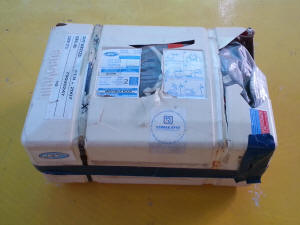 |
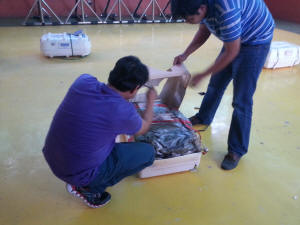 |
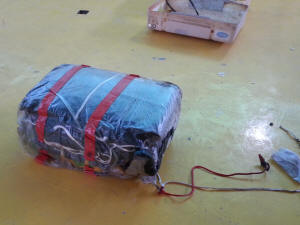 |
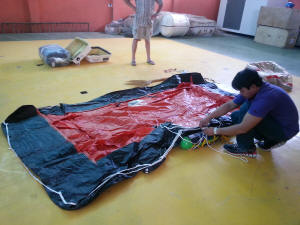 |
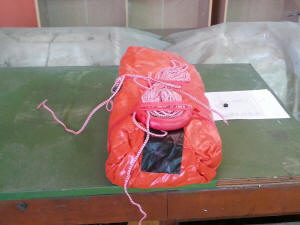 |
 |
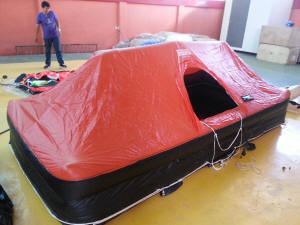 |
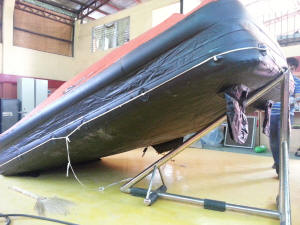 |
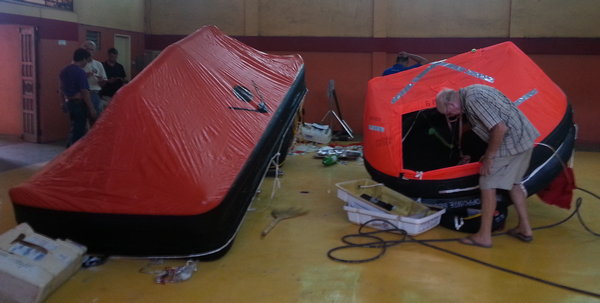 |
|
We have 3 very well-provisioned "ditch bags" plus several 1-gallon jugs of water near the cockpit ready to go, if we need to abandon ship.

